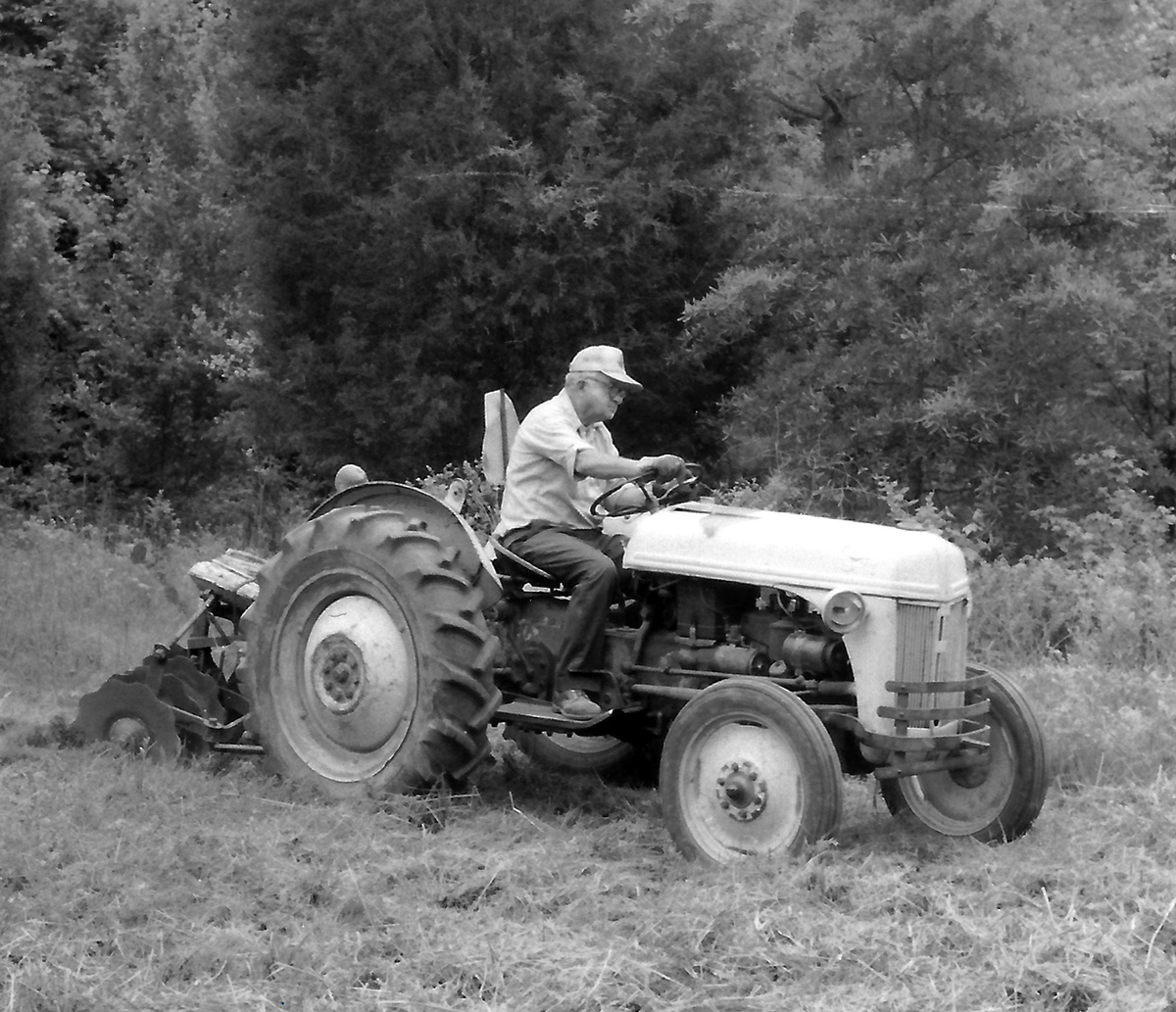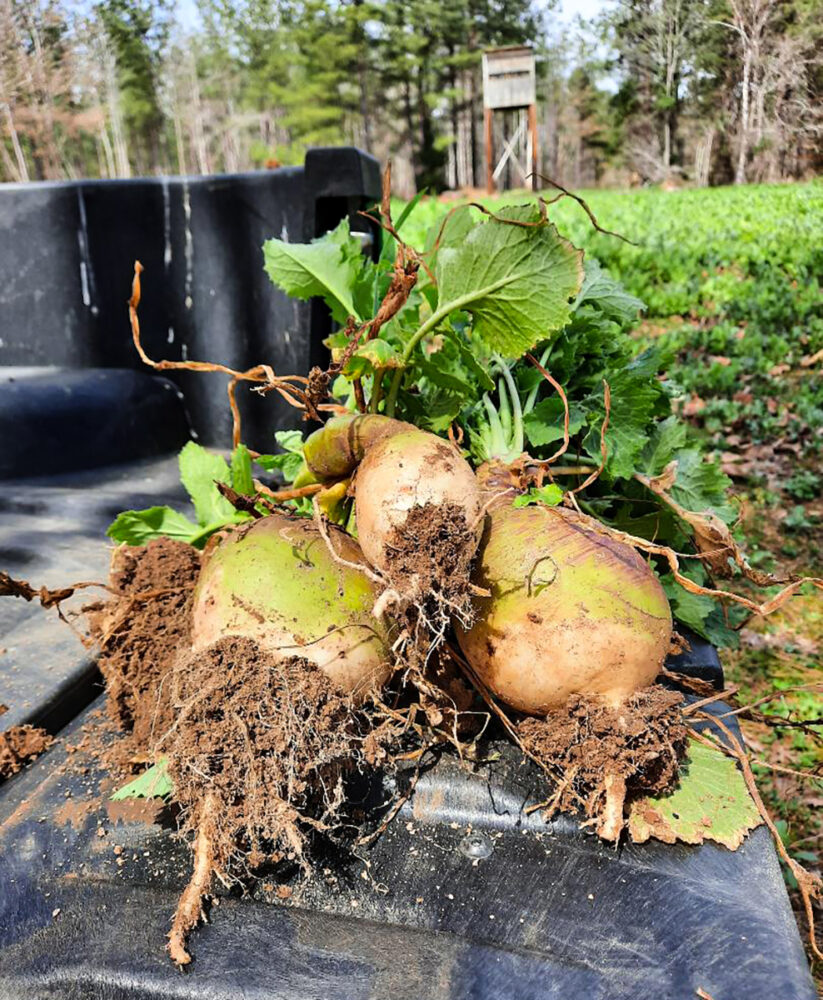
In order to control weeds before planting, food plots must be sprayed. Talk with your county extension agent or the local feed and seed dealer for the herbicide that they recommend.
By Denny Quaiff for Whitetail Times
Photos by Denny Quaiff
My first experience with building and maintaining food plots began in the late 1970s. Spears Hunt Club was expanding their hunting lease in Chesterfield County and decided to follow the trend of creating wildlife food plots that was spreading throughout the country. The late Lawrence E. Hall, with his 8N-Ford Tractor, was the backbone behind our new venture. The tractor equipment consists of a two-bottom plow, pull-behind disk, and a 12-foot drag that belonged to my father. I remember walking the field with a 20-pound seed spreader ahead of the tractor and drag that completed the job.

The days gone by of plowing and disking food plots has shifted to the modern-day practice of no-till farming. Things have greatly changed from when Mr. Lawrence E. Hall and his 8N Ford Tractor worked food plots back in the day.
Today, our Amelia Springs Hunt Club has more than 40 acres of food plots. The three tractors that we use are the 5425, 5105 and the 4500 John Deere series. The tractors belong to club members Nick Hall, Clifford Wells, and Taylor Phillips. Hunt clubs rely on the support of their members for projects. Without the backing of these men, this big undertaking would have fallen short of the outstanding results we achieved.
Spray for Herbicide Application
A sprayer is the first implement needed to apply herbicide and control tough and resilient weeds before planting food plots. Our sprayer has a 300-gallon tank and a 16-foot span that’s controlled by the tractor’s power take-off. By mixing two 2½ gallon containers with 300 gallons of water we have experienced a consistent burn throughout the plots. Talk with your local supply store about affordable and effective herbicide options for your area. Spraying your plots is a must; schedule the work at least one week before planting for the best results.
Test Your Soil and Apply Lime and Fertilizer
Seed should be planted in a seed bed that has a pH between 6.5 and 7.5. It’s always best to have a soil test analysis, and most agricultural universities and co-op seed companies offer this service. We have used Virginia Tech in the past and have been very pleased with their Agricultural Department. This practice should be your first step before getting started and will save money in the long-run.
Most soil tests will recommend lime. Lime is far less expensive than fertilizer and will help balance the pH and naturalize the soil. We have lime delivered in 20-ton loads. Most sites require one to three tons of lime to the acre, but this can vary based on the soil test. After spreading lime, it is advisable to disk it 4 to 5 inches into the soil. Lime will start to work in a couple of weeks. However, try to apply lime to your food plot at least four months before planting for the best results.
Over the past few years, we have been using chicken litter on our plots with great success. The Animal Waste Analysis Report that was done by Clemson University was informative, showing that the chicken litter is 3.99% nitrogen, 3.63% phosphate and 4.3% potash. Not only have we been very satisfied with how our plots have produced, but the cost savings over fertilizer have been a bonus.
When I was a teenager working with my father on the farm back in the 1960s, we had cows, chickens, and hogs. The abundance of manure was endless, and we had a manure spreader that pulled behind the tractor. I remember my father saying, “The more it stinks the less it’s working.” When the manure is just spread on the landscape it’s easier for the nitrogen to be lost to the air in the form of ammonia. If you use chicken litter, disk it in for the best results. It’s provided great results for our food plot management.
Fall Food Plots
When planting brassica food plots, I like to plant a variety of rape, purple-top turnips, and kale. The rape and kale grow into leaf production that provides for a lot of forage and really draws deer after the first killing frost. Turnips are late-season and winter feed for whitetails. Deer will paw and dig up the turnips in late winter. Ice storms like we experienced this past winter make it hard on wildlife. The turnips planted in the fall became a prime food source. My father always planted his turnips around August 15. This is a proven late summer timeline. Our food plots last year produced banner crops and the consistent rainfall that the Good Lord provided deserves a great deal of the credit.

Turnips will provide a late winter feed for deer. If planted in mid to late August with good PH levels documented by a professional soil test analysis, food plots will yield blue-ribbon crops.
In the fall, we always reseed our ladino clover plots and over-seed those sites with winter oats. The ladino clover will go dormant in the late season and deer will continue to browse the oats throughout winter.
One thing I have learned about planting food plots is to space out the different crop locations. If the food plot is for hunting, you want deer to have a reason to move. Planting a brassica plot in sight of another is not the way to concentrate the deer you are hunting. The size of your food plot should also influence what you plant. It’s been my experience that crops like corn and soybeans will not survive on a small site. Plots like brassicas, oats and clovers will stand more browsing and keep deer coming back throughout the season.
Established food plots will draw deer like a magnet and over-anxious hunters will so often over-hunt these sites. Always pay close attention to the wind directions and look for travel corridors between bedding areas and food plots. Mature bucks and does recognize hunting pressure around food plots that will very often find deer only using these sites after legal shooting hours. Have a plan in place for your food plot management and try to determine what is best suited for your property. Hard work and competent planning will be rewarded when the season rolls around.
The Latest in Food Plot Equipment
This past summer we were interested in a no-till drill for our food plot work. The days of plowing, disking, and dragging a field have all changed with the no-till planting equipment that’s being manufactured today. The no-till farming practice decreases the amount of soil erosion that tilling can cause in certain soils, especially in sandy and dry soils on sloping terrain. It also helps with less soil compaction resulting from multiple passes over a field with heavy tractor equipment.
Because the soil isn’t constantly being cultivated, fertilizers last for a longer period of time. The no-till practice also helps keep the soil moist longer and fight hot dry weather conditions. When you consider that time is money, the significant savings in fuel alone, less work and higher crop yields, it comes as no surprise that more farmers have switched to no-till-farming.
Our food plot multi-tool drill allows the operator to disk and plant, and the trailing cultipacker firms the seed bed for seed-to-soil contact to trap moisture for consistent germination throughout the site. One pass of the field completes the job. The small seed box allows for a shallow depth setting for planting the fine brassicas and clover seed, while the big box that holds 300 pounds can be set at a deeper depth for oats, wheat, or rye. All seed boxes can be engaged and disengaged independently with a single pin; no tools required. With our 72-inch drill we averaged planting two acres an hour
One important point that should not be overlooked when working with farm equipment is safety. Have a complete understanding of the manufacturer’s safety features and wear the seat belt when the tractor is in use. Take extra precaution when attaching equipment to the power take-off. Guard against any mishaps when loading or unloading the tractor. Be responsible and use common sense. Make safety your number-one priority.
Conclusion
Today the magazine ads in hunting publications and commercials on the outdoor channels are flooded with companies advertising food plot products and the latest equipment for the job. Some of these companies have been around for years and they have built a good reputation. Some are new players in the market place trying to build their customer base. Make sure you do your homework. Research the products and equipment you are considering purchasing to make educated decisions.
The challenge of building and maintaining good food plots is a step in the right direction for quality deer management. All that I have recommended in this article have been tested with good results. Hopefully, I have provided you some ways to make sound decisions about food plots on your land. We all desire better deer and deer hunting. Working to manage your local deer herd can be a rewarding experience that will render a high level of satisfaction along the way!
©Virginia Deer Hunters Association. For attribution information and reprint rights, contact Denny Quaiff, Executive Director, VDHA.


